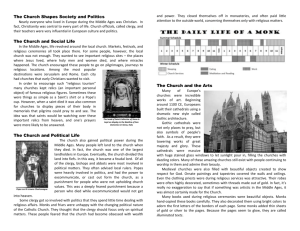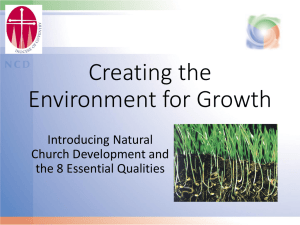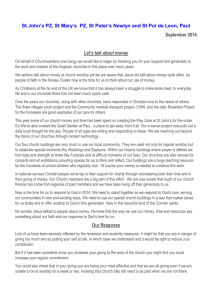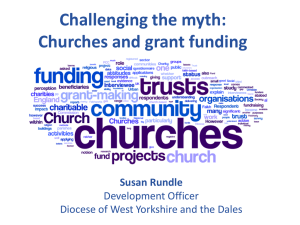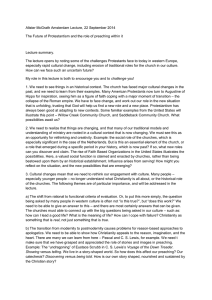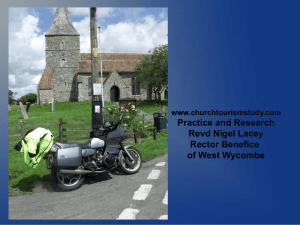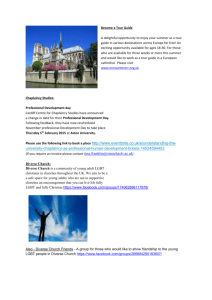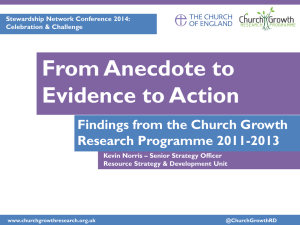file - From Evidence to Action
advertisement
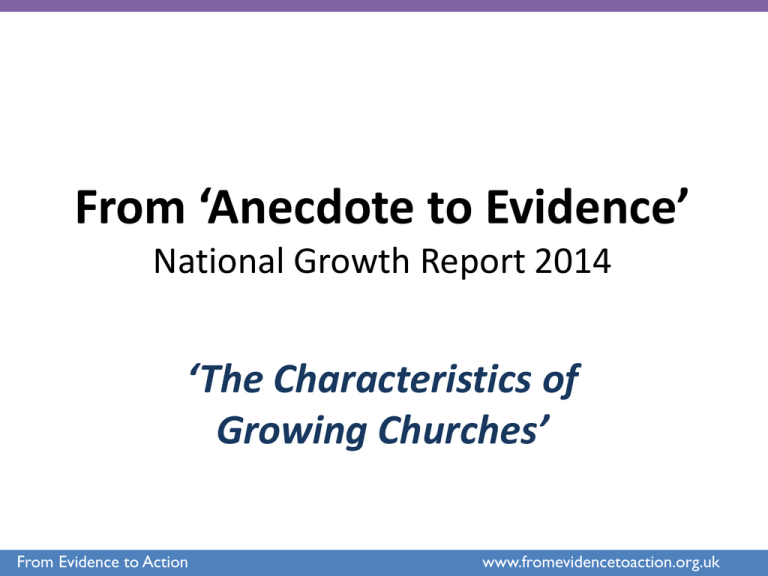
From ‘Anecdote to Evidence’ National Growth Report 2014 ‘The Characteristics of Growing Churches’ From FromEvidence EvidencetotoAction Action www.fromevidencetoaction.org.uk www.fromevidencetoaction.org.uk The British church is shrinking! – In 1960, 24% of people went to church In 2000, only 12% of people went – Since then, 1000 people a week have been leaving the Church of England – Nearly half our present attendance is over 65 – So church attendance will halve again within just 20 years. From FromEvidence EvidencetotoAction Action www.fromevidencetoaction.org.uk www.fromevidencetoaction.org.uk The way life used to be • Church was at the centre of community life • People’s lives gravitated towards the church • Church growth about was working with those connections creatively – Drawing those who came: • from the door • to the font • to the altar • to the world From Evidence to Action www.fromevidencetoaction.org.uk How things are today Church Grace Davies: Vicarious Religion. Church as ‘Firestation’ From Evidence to Action www.fromevidencetoaction.org.uk Sometimes the odds are against us! From Evidence to Action www.fromevidencetoaction.org.uk The Tough Reality Less people = less income = less stipendiary clergy = A CHOICE. a) We manage decline and administer palliative care to our churches. b) We develop new ways of being the church a commit ourselves to growth. From Evidence to Action www.fromevidencetoaction.org.uk Why are we declining? Religious affiliation by year of birth; Among the old, 1 in 2 are C of E, among the young 1 in 20 ... From Evidence to Action www.fromevidencetoaction.org.uk http://www.churchgro wthresearch.org.uk/ “NO SINGLE RECIPE” FOR GROWTH From Evidence to Action www.fromevidencetoaction.org.uk From Evidence to Action www.fromevidencetoaction.org.uk 1.Churches that have a clear mission and purpose. Do we know why we exist? The 5 Marks of Mission 1. To proclaim the Good News of the Kingdom. 2. To teach, baptise and nurture new believers. 3. To respond to human need by loving service. 4. To seek to transform unjust structures of society. 5. To strive to safeguard the integrity of creation and sustain and renew the life of the earth. From Evidence to Action www.fromevidencetoaction.org.uk 2.Clergy & Congregations who are intentional about and prioritise growth • Why would we want to grow? We like our ‘cosy little club’ as it is….. • Our not yet member is our greatest priority…. Who are they? Where are they? Why don’t they? What can we? From Evidence to Action www.fromevidencetoaction.org.uk 3. Clergy & worshippers who are willing to change & adapt “Habit is habit, and not to be flung out of the window by any man, but coaxed downstairs a step at a time” (Mark Twain) From Evidence to Action www.fromevidencetoaction.org.uk 4. Churches where Lay people as well as Ordained Clergy are active in leadership and other roles • Churches where the Vicar does everything or where there is little rotation of lay people in key roles are less likely to be growing. • Churches with a lay & ordained ‘ministry team’ are more likely to be growing. From Evidence to Action www.fromevidencetoaction.org.uk 5. Churches that actively engage with children & young people. • One fifth of our churches have no under 16s at all. • Only 36% of Anglicans surveyed felt that it was especially important for their children to learn religious faith at home. • Churches that employ a Children’s / Youth worker are half as likely to be declining From Evidence to Action www.fromevidencetoaction.org.uk 6. Churches with a welcoming culture who build on going relationships with people • Welcoming churches grow. • BUT the most growth happens in churches that go ‘beyond’ welcome. ‘I don’t want a friendly church, I want a church where I can make friends’ From Evidence to Action www.fromevidencetoaction.org.uk 7. Churches that nurture Disciples • Regular opportunities to learn about the faith characterise growing churches. • Teaching that applies to ‘real life’ makes a difference. From Evidence to Action www.fromevidencetoaction.org.uk 8. Clergy / Leaders who innovate, envision & motivate people. • Quality of leadership both lay & ordained is linked to growth. • Churchmanship or gender was not significant to growth but ‘distinctiveness’ was…. • ‘We know who we are and we will do it well’ The importance of prayer. ‘Now to him who is able to do immeasurably more than all we ask or imagine, according to his power that is at work within us’ Eph 3:20 From Evidence to Action www.fromevidencetoaction.org.uk
